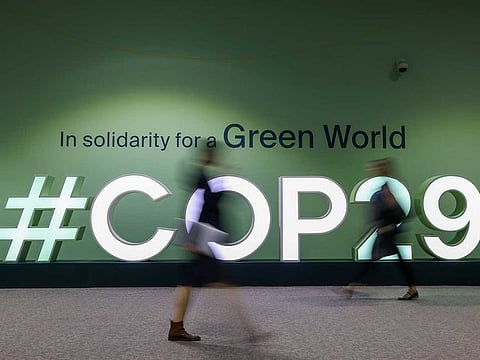Breakthrough or bust? COP29’s $300B climate promise
Climate funds are ambitious, but it must be ensured that money is effectively utilised

“Successful investing is about managing risks, not avoiding them,” said American economist, Benjamin Graham.
The 29th United Nations Climate Change Conference (COP29) held in Baku, Azerbaijan last month lived up to the saying. It brought together 200 countries and reached a breakthrough agreement tripling finance to developing countries to overcome environmental challenges.
The previous goal of $100 billion annually, was increased to $300 billion annually by 2035. This includes efforts to mobilise $1.3 trillion from public and private sources — a lifeline for those most vulnerable to the ravages of climate change.
Though least responsible for its causes, these nations face threats of storms, floods and droughts that threaten to erase communities and economies.
However, they strongly opposed the agreed-upon amount and how the agreement was adopted after hassles and deliberations.
It must be noted that $300 billion in 2035 is presently equivalent to $180 billion and in 2020, it equalled $140 billion. Thus, it’s like buying 15 years of climate change future for merely $40 billion.
Their dissent was justified. The industrialised world (which grew wealthy through carbon-incentive development), bears a moral responsibility to fund their transition to greener futures. The funds will prevent them from slipping into further distress and ensure justice and equal opportunity for a greener economy and resilience against the climate crisis.
Also Read: COP1: Flagship for global climate action
The target, known as the New Collective Quantified Goal (NCQG), replaces the previous commitment.
Earlier, developed countries pledged to mobilise $100 billion annually in climate finance, an amount that had not been realised for long. When it came, a large portion (over 69 per cent) was in the form of loans, adding to the debt burden of several vulnerable nations.
COP29 highlighted the urgent need to support such nations in tackling emissions, transitioning to renewable energy and adapting to the impacts of climate change.
Still, viewing the earlier unmet financial commitments, climate experts are sceptical of the feasibility of the new promised target. They state that the pledged amount may not be imparted due to a lack of concrete mechanisms and accountability.
Nevertheless, the Nationally Determined Contributions (NDCs) due in 2025, will be the real measure of progress. The improvement will be reviewed periodically in 2026 and 2027 and a decision review in 2030.
Renewed vigour and aims
Over 55,000 people attended COP29 to share ideas and solutions and build partnerships and coalitions.
Intense negotiations and significant agreements marked the event. The discussions included a global agreement to transition away from all fossil fuels in energy systems, triple renewable energy and boost climate resilience.
The new plans must cover all greenhouse gases (GHGs) and all sectors to keep the 1.5°C warming limit within reach.
COP29 also agreed on carbon markets, to which several previous COPs did not consent. These agreements will help countries deliver their climate plans efficiently and economically and, as required, make faster progress in halving emissions this decade.
Additionally, strengthened efforts to support vulnerable communities were emphasised. This comprised enhancing transparency in climate reporting and ensuring that adaptation measures were implemented effectively.
Youth at the forefront
Besides finance to developing countries, youth participation was another major highlight of the conference. The event discussed capacity-building needs and priorities to support youth empowerment at the global level.
The Next-Generation Leader Development Program had trained a few high school students, and two joined COP29, sharing experiences and insights in addressing global environmental challenges, featuring diverse perspectives.
Dedicated spaces were created to ensure the meaningful participation of youth and civil society members, stressing the importance of inclusivity and intergenerational collaboration.
Engaging in high-level discussions with negotiators, they emphasised the need for immediate and concrete actions. Vocal in their demands for stronger accountability, they ensured their voices were heard in the negotiations.
Opting out of traditional speeches, young eco-activists from across the globe presented their visions and perspectives on tackling climate change and the challenges they encounter in taking significant steps toward preventing a catastrophe.
Demands of the time
However, despite the significant agreements reached at COP29, challenges remain.
Analysts say the climate funds promise is ambitious but its success depends on the commitment and cooperation of all parties involved. Ensuring the funds are mobilised and utilised constructively will be crucial in the coming years.
The next major milestone will be COP30, where the focus will likely be on implementing the agreements and addressing the gaps in climate finance and activity.
As Simon Stiell, Executive Secretary of UN Climate Change, remarked, “This new finance goal is an insurance policy for humanity amid worsening climate impacts hitting every country. But like any insurance policy — it only works — if premiums are paid in full, and on time. Promises must be kept to protect billions of lives.”
He stressed, “It will keep the clean energy boom growing, helping all countries to share in its huge benefits: more jobs, stronger growth, cheaper and cleaner energy for all.”
(Next week, the author will summarise his new book release ‘Climate Change Enigma - A delicate balance’)
Dr Abdullah Belhaif Al Nuaimi is Chairman of the Advisory Council of the Emirate of Sharjah
Sign up for the Daily Briefing
Get the latest news and updates straight to your inbox



